International Institute of Technology ADACC Chapter 7 Assessment
VerifiedAdded on 2022/09/01
|17
|3797
|20
Homework Assignment
AI Summary
This document presents a student's completed assessment booklet for Chapter 7 of the Advanced Diploma of Accounting (ADACC) course, focusing on corporate governance. The assessment covers key concepts such as the factors determining non-executive director independence, ethical dilemmas faced by accountants regarding inventory valuation, the role of accounting in corporate governance, the difference between corporate governance and management, and the evaluation of corporate governance in a hypothetical company seeking a stock market listing. The assignment also explores examples of conflicts of interest for directors, situations involving a director's failure to act with reasonable care, and the role of the audit committee in protecting the independence of external auditors. The student's answers demonstrate an understanding of these concepts and their practical application within a business context, providing insights into the complexities of corporate governance and accounting practices.
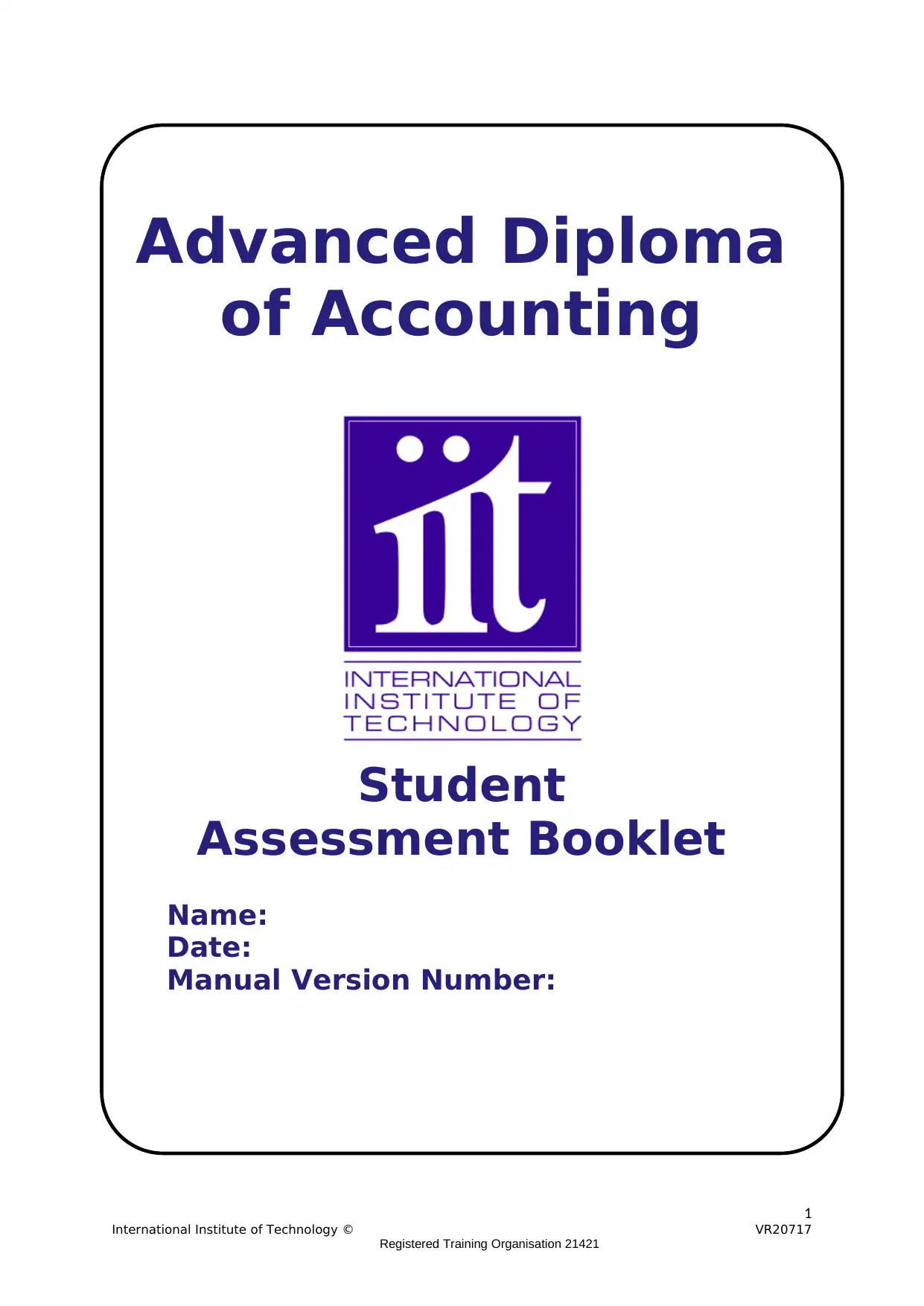
Advanced Diploma
of Accounting
Student
Assessment Booklet
Name:
Date:
Manual Version Number:
1
International Institute of Technology © VR20717
Registered Training Organisation 21421
of Accounting
Student
Assessment Booklet
Name:
Date:
Manual Version Number:
1
International Institute of Technology © VR20717
Registered Training Organisation 21421
Paraphrase This Document
Need a fresh take? Get an instant paraphrase of this document with our AI Paraphraser
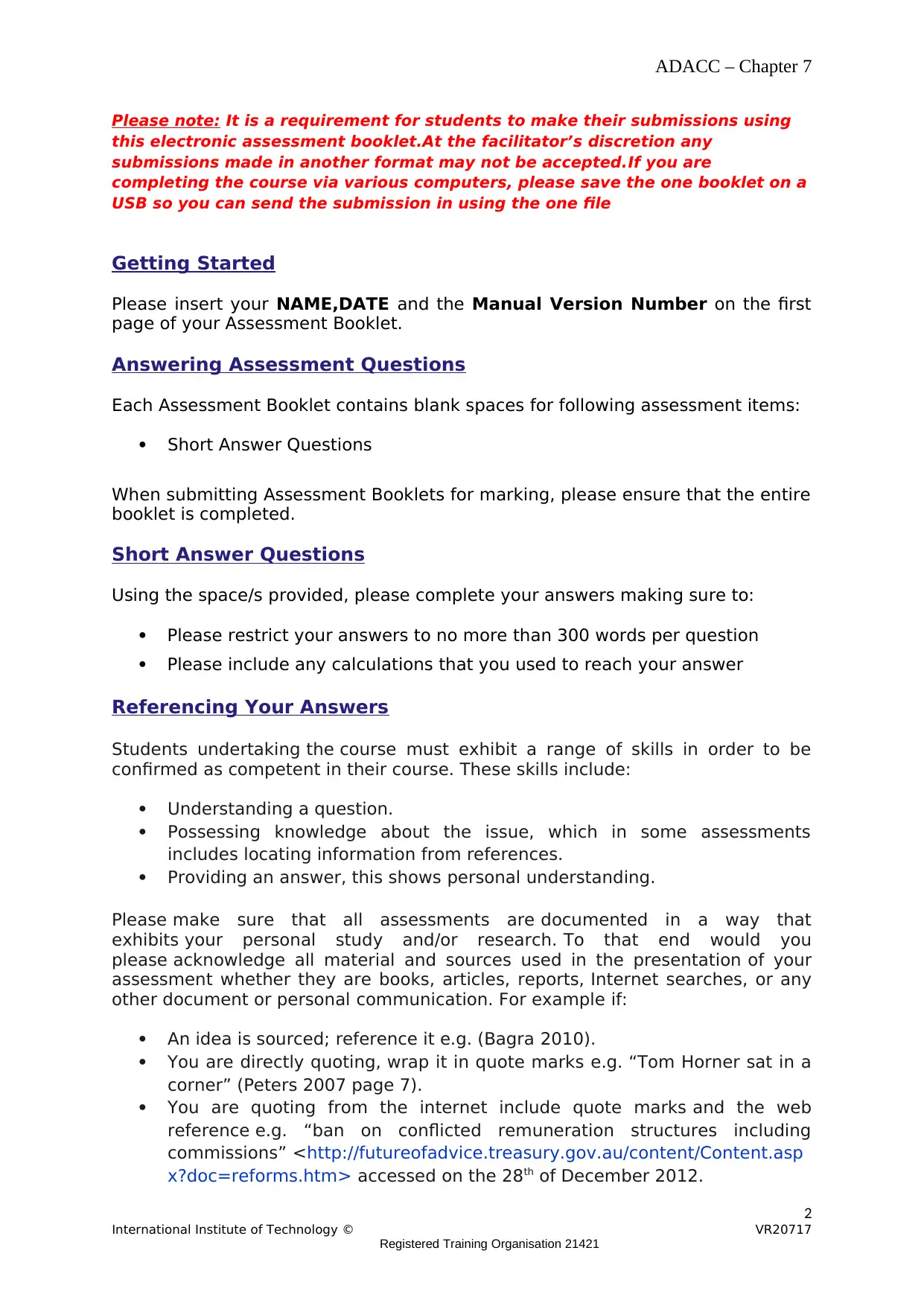
ADACC – Chapter 7
Please note: It is a requirement for students to make their submissions using
this electronic assessment booklet.At the facilitator’s discretion any
submissions made in another format may not be accepted.If you are
completing the course via various computers, please save the one booklet on a
USB so you can send the submission in using the one file
Getting Started
Please insert your NAME,DATE and the Manual Version Number on the first
page of your Assessment Booklet.
Answering Assessment Questions
Each Assessment Booklet contains blank spaces for following assessment items:
Short Answer Questions
When submitting Assessment Booklets for marking, please ensure that the entire
booklet is completed.
Short Answer Questions
Using the space/s provided, please complete your answers making sure to:
Please restrict your answers to no more than 300 words per question
Please include any calculations that you used to reach your answer
Referencing Your Answers
Students undertaking the course must exhibit a range of skills in order to be
confirmed as competent in their course. These skills include:
Understanding a question.
Possessing knowledge about the issue, which in some assessments
includes locating information from references.
Providing an answer, this shows personal understanding.
Please make sure that all assessments are documented in a way that
exhibits your personal study and/or research. To that end would you
please acknowledge all material and sources used in the presentation of your
assessment whether they are books, articles, reports, Internet searches, or any
other document or personal communication. For example if:
An idea is sourced; reference it e.g. (Bagra 2010).
You are directly quoting, wrap it in quote marks e.g. “Tom Horner sat in a
corner” (Peters 2007 page 7).
You are quoting from the internet include quote marks and the web
reference e.g. “ban on conflicted remuneration structures including
commissions” <http://futureofadvice.treasury.gov.au/content/Content.asp
x?doc=reforms.htm> accessed on the 28th of December 2012.
2
International Institute of Technology © VR20717
Registered Training Organisation 21421
Please note: It is a requirement for students to make their submissions using
this electronic assessment booklet.At the facilitator’s discretion any
submissions made in another format may not be accepted.If you are
completing the course via various computers, please save the one booklet on a
USB so you can send the submission in using the one file
Getting Started
Please insert your NAME,DATE and the Manual Version Number on the first
page of your Assessment Booklet.
Answering Assessment Questions
Each Assessment Booklet contains blank spaces for following assessment items:
Short Answer Questions
When submitting Assessment Booklets for marking, please ensure that the entire
booklet is completed.
Short Answer Questions
Using the space/s provided, please complete your answers making sure to:
Please restrict your answers to no more than 300 words per question
Please include any calculations that you used to reach your answer
Referencing Your Answers
Students undertaking the course must exhibit a range of skills in order to be
confirmed as competent in their course. These skills include:
Understanding a question.
Possessing knowledge about the issue, which in some assessments
includes locating information from references.
Providing an answer, this shows personal understanding.
Please make sure that all assessments are documented in a way that
exhibits your personal study and/or research. To that end would you
please acknowledge all material and sources used in the presentation of your
assessment whether they are books, articles, reports, Internet searches, or any
other document or personal communication. For example if:
An idea is sourced; reference it e.g. (Bagra 2010).
You are directly quoting, wrap it in quote marks e.g. “Tom Horner sat in a
corner” (Peters 2007 page 7).
You are quoting from the internet include quote marks and the web
reference e.g. “ban on conflicted remuneration structures including
commissions” <http://futureofadvice.treasury.gov.au/content/Content.asp
x?doc=reforms.htm> accessed on the 28th of December 2012.
2
International Institute of Technology © VR20717
Registered Training Organisation 21421
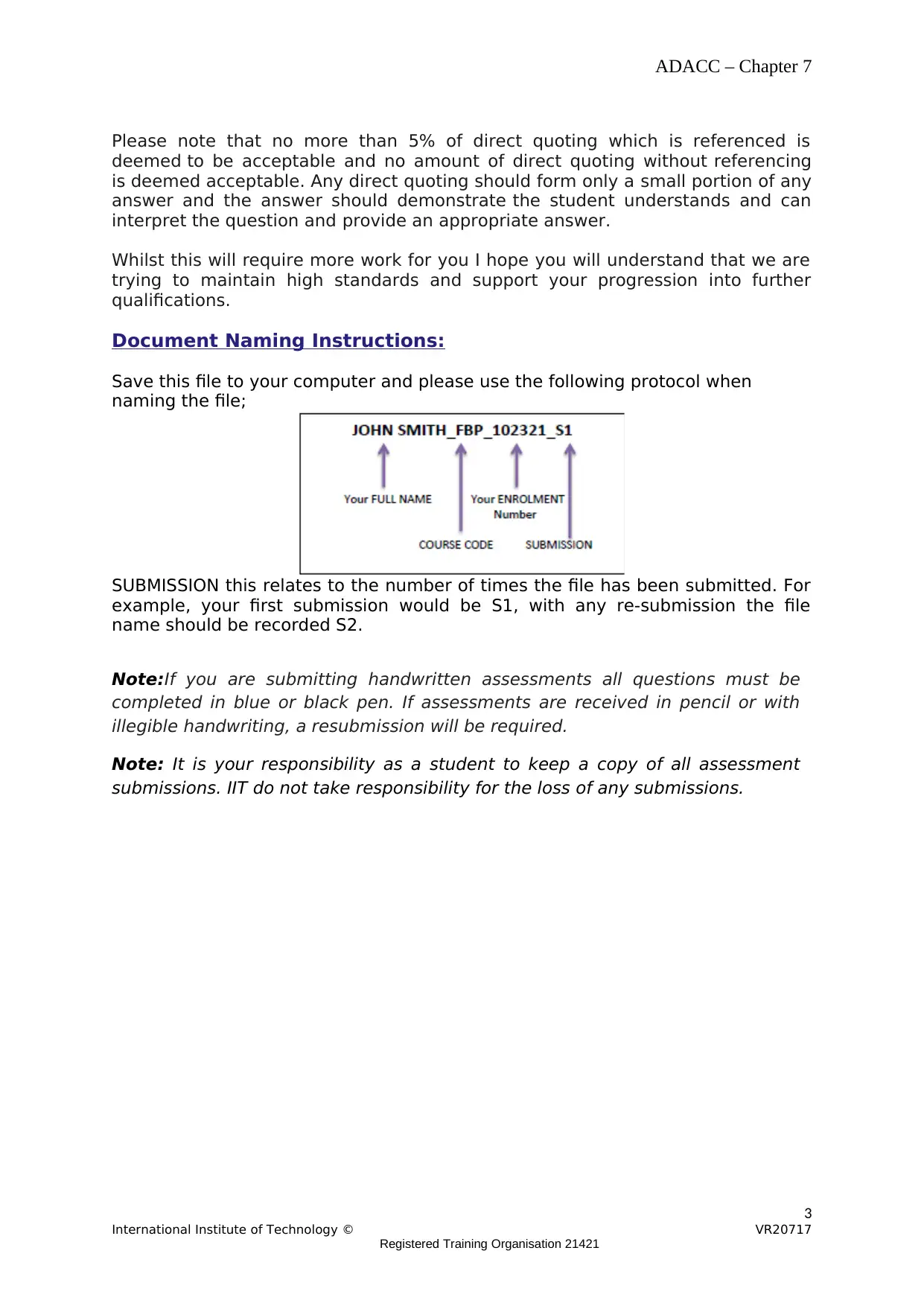
ADACC – Chapter 7
Please note that no more than 5% of direct quoting which is referenced is
deemed to be acceptable and no amount of direct quoting without referencing
is deemed acceptable. Any direct quoting should form only a small portion of any
answer and the answer should demonstrate the student understands and can
interpret the question and provide an appropriate answer.
Whilst this will require more work for you I hope you will understand that we are
trying to maintain high standards and support your progression into further
qualifications.
Document Naming Instructions:
Save this file to your computer and please use the following protocol when
naming the file;
SUBMISSION this relates to the number of times the file has been submitted. For
example, your first submission would be S1, with any re-submission the file
name should be recorded S2.
Note:If you are submitting handwritten assessments all questions must be
completed in blue or black pen. If assessments are received in pencil or with
illegible handwriting, a resubmission will be required.
Note: It is your responsibility as a student to keep a copy of all assessment
submissions. IIT do not take responsibility for the loss of any submissions.
Distance Education Students
3
International Institute of Technology © VR20717
Registered Training Organisation 21421
Please note that no more than 5% of direct quoting which is referenced is
deemed to be acceptable and no amount of direct quoting without referencing
is deemed acceptable. Any direct quoting should form only a small portion of any
answer and the answer should demonstrate the student understands and can
interpret the question and provide an appropriate answer.
Whilst this will require more work for you I hope you will understand that we are
trying to maintain high standards and support your progression into further
qualifications.
Document Naming Instructions:
Save this file to your computer and please use the following protocol when
naming the file;
SUBMISSION this relates to the number of times the file has been submitted. For
example, your first submission would be S1, with any re-submission the file
name should be recorded S2.
Note:If you are submitting handwritten assessments all questions must be
completed in blue or black pen. If assessments are received in pencil or with
illegible handwriting, a resubmission will be required.
Note: It is your responsibility as a student to keep a copy of all assessment
submissions. IIT do not take responsibility for the loss of any submissions.
Distance Education Students
3
International Institute of Technology © VR20717
Registered Training Organisation 21421
⊘ This is a preview!⊘
Do you want full access?
Subscribe today to unlock all pages.

Trusted by 1+ million students worldwide
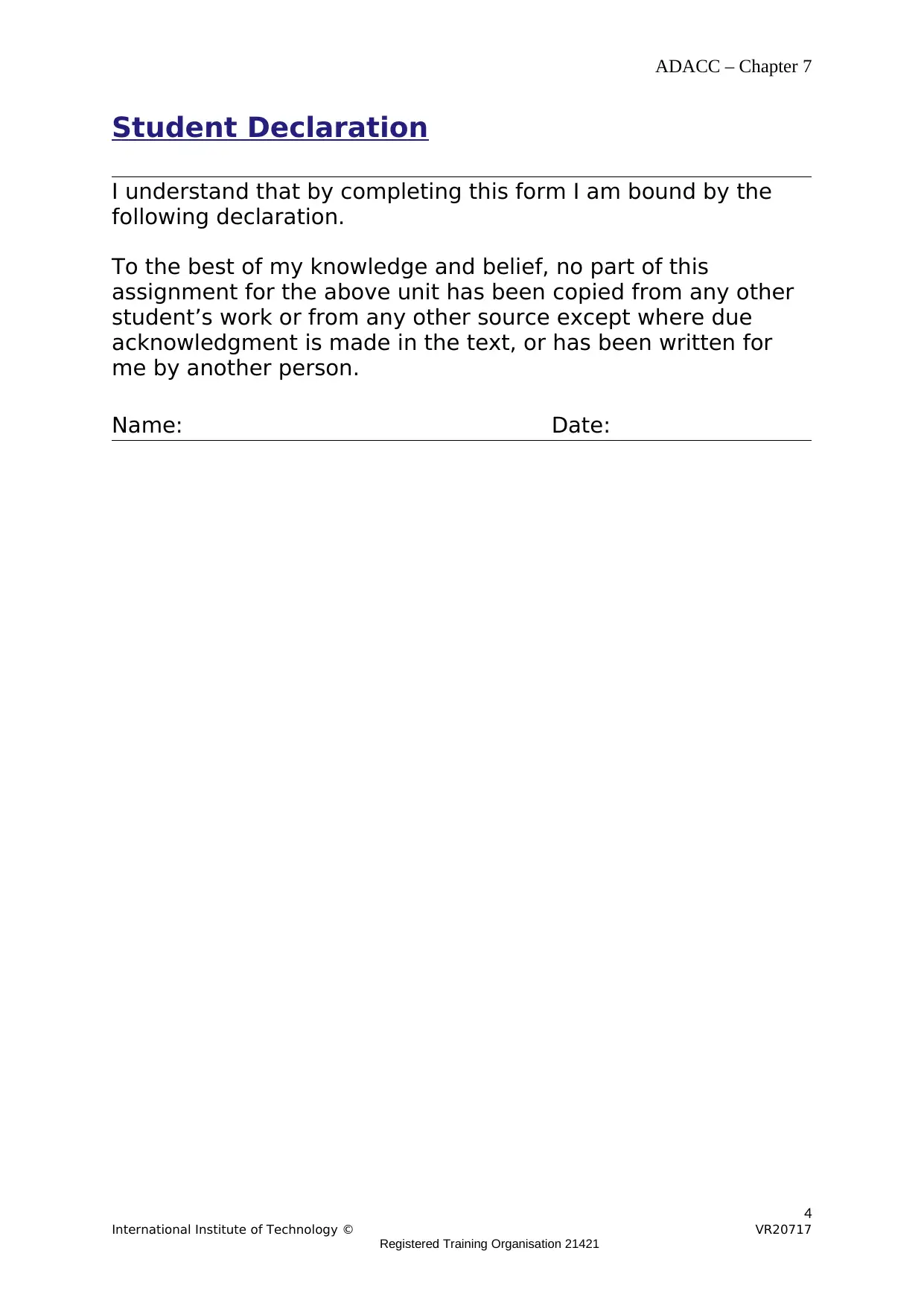
ADACC – Chapter 7
Student Declaration
I understand that by completing this form I am bound by the
following declaration.
To the best of my knowledge and belief, no part of this
assignment for the above unit has been copied from any other
student’s work or from any other source except where due
acknowledgment is made in the text, or has been written for
me by another person.
Name: Date:
4
International Institute of Technology © VR20717
Registered Training Organisation 21421
Student Declaration
I understand that by completing this form I am bound by the
following declaration.
To the best of my knowledge and belief, no part of this
assignment for the above unit has been copied from any other
student’s work or from any other source except where due
acknowledgment is made in the text, or has been written for
me by another person.
Name: Date:
4
International Institute of Technology © VR20717
Registered Training Organisation 21421
Paraphrase This Document
Need a fresh take? Get an instant paraphrase of this document with our AI Paraphraser
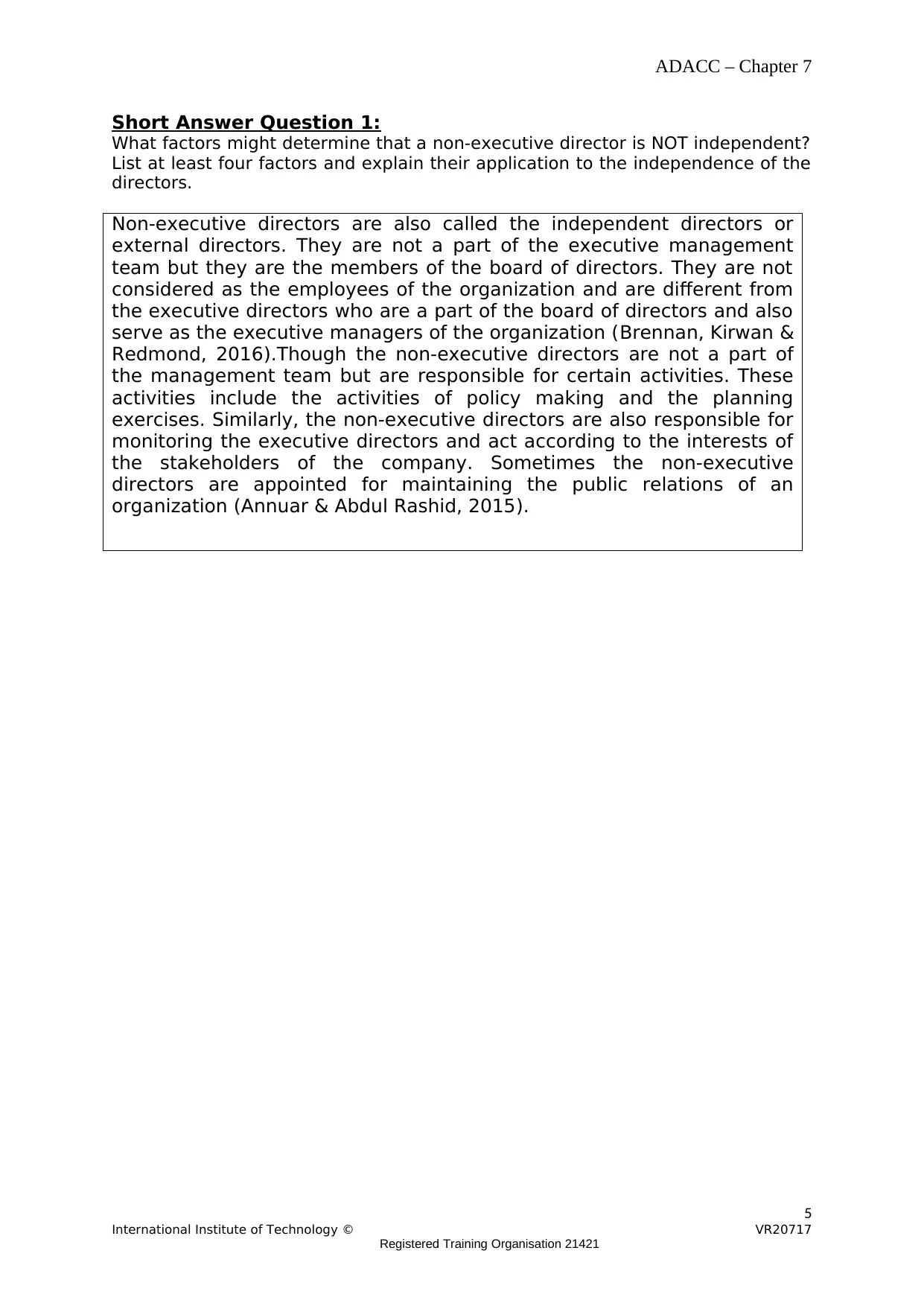
ADACC – Chapter 7
Short Answer Question 1:
What factors might determine that a non-executive director is NOT independent?
List at least four factors and explain their application to the independence of the
directors.
Non-executive directors are also called the independent directors or
external directors. They are not a part of the executive management
team but they are the members of the board of directors. They are not
considered as the employees of the organization and are different from
the executive directors who are a part of the board of directors and also
serve as the executive managers of the organization (Brennan, Kirwan &
Redmond, 2016).Though the non-executive directors are not a part of
the management team but are responsible for certain activities. These
activities include the activities of policy making and the planning
exercises. Similarly, the non-executive directors are also responsible for
monitoring the executive directors and act according to the interests of
the stakeholders of the company. Sometimes the non-executive
directors are appointed for maintaining the public relations of an
organization (Annuar & Abdul Rashid, 2015).
5
International Institute of Technology © VR20717
Registered Training Organisation 21421
Short Answer Question 1:
What factors might determine that a non-executive director is NOT independent?
List at least four factors and explain their application to the independence of the
directors.
Non-executive directors are also called the independent directors or
external directors. They are not a part of the executive management
team but they are the members of the board of directors. They are not
considered as the employees of the organization and are different from
the executive directors who are a part of the board of directors and also
serve as the executive managers of the organization (Brennan, Kirwan &
Redmond, 2016).Though the non-executive directors are not a part of
the management team but are responsible for certain activities. These
activities include the activities of policy making and the planning
exercises. Similarly, the non-executive directors are also responsible for
monitoring the executive directors and act according to the interests of
the stakeholders of the company. Sometimes the non-executive
directors are appointed for maintaining the public relations of an
organization (Annuar & Abdul Rashid, 2015).
5
International Institute of Technology © VR20717
Registered Training Organisation 21421
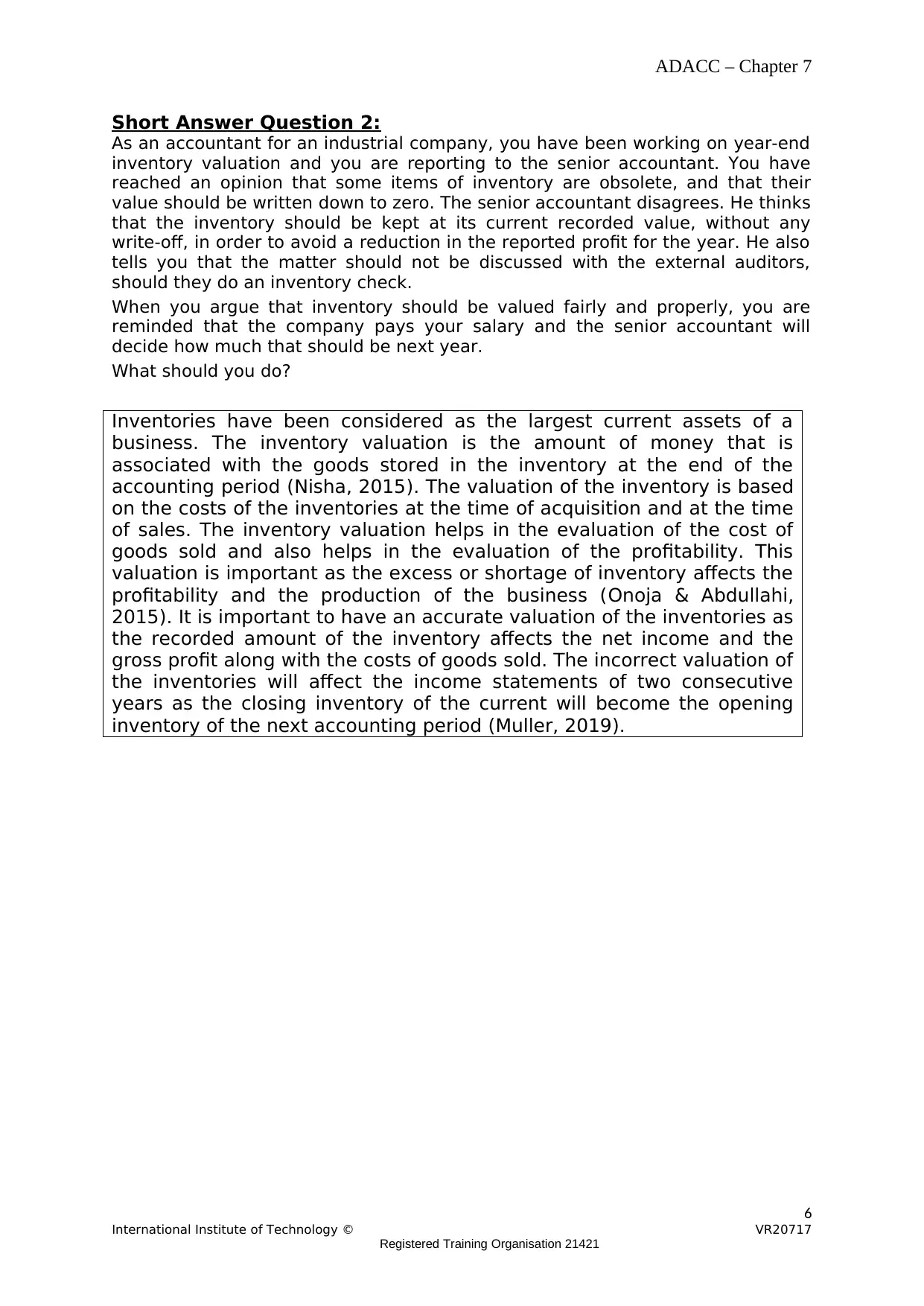
ADACC – Chapter 7
Short Answer Question 2:
As an accountant for an industrial company, you have been working on year-end
inventory valuation and you are reporting to the senior accountant. You have
reached an opinion that some items of inventory are obsolete, and that their
value should be written down to zero. The senior accountant disagrees. He thinks
that the inventory should be kept at its current recorded value, without any
write-off, in order to avoid a reduction in the reported profit for the year. He also
tells you that the matter should not be discussed with the external auditors,
should they do an inventory check.
When you argue that inventory should be valued fairly and properly, you are
reminded that the company pays your salary and the senior accountant will
decide how much that should be next year.
What should you do?
Inventories have been considered as the largest current assets of a
business. The inventory valuation is the amount of money that is
associated with the goods stored in the inventory at the end of the
accounting period (Nisha, 2015). The valuation of the inventory is based
on the costs of the inventories at the time of acquisition and at the time
of sales. The inventory valuation helps in the evaluation of the cost of
goods sold and also helps in the evaluation of the profitability. This
valuation is important as the excess or shortage of inventory affects the
profitability and the production of the business (Onoja & Abdullahi,
2015). It is important to have an accurate valuation of the inventories as
the recorded amount of the inventory affects the net income and the
gross profit along with the costs of goods sold. The incorrect valuation of
the inventories will affect the income statements of two consecutive
years as the closing inventory of the current will become the opening
inventory of the next accounting period (Muller, 2019).
6
International Institute of Technology © VR20717
Registered Training Organisation 21421
Short Answer Question 2:
As an accountant for an industrial company, you have been working on year-end
inventory valuation and you are reporting to the senior accountant. You have
reached an opinion that some items of inventory are obsolete, and that their
value should be written down to zero. The senior accountant disagrees. He thinks
that the inventory should be kept at its current recorded value, without any
write-off, in order to avoid a reduction in the reported profit for the year. He also
tells you that the matter should not be discussed with the external auditors,
should they do an inventory check.
When you argue that inventory should be valued fairly and properly, you are
reminded that the company pays your salary and the senior accountant will
decide how much that should be next year.
What should you do?
Inventories have been considered as the largest current assets of a
business. The inventory valuation is the amount of money that is
associated with the goods stored in the inventory at the end of the
accounting period (Nisha, 2015). The valuation of the inventory is based
on the costs of the inventories at the time of acquisition and at the time
of sales. The inventory valuation helps in the evaluation of the cost of
goods sold and also helps in the evaluation of the profitability. This
valuation is important as the excess or shortage of inventory affects the
profitability and the production of the business (Onoja & Abdullahi,
2015). It is important to have an accurate valuation of the inventories as
the recorded amount of the inventory affects the net income and the
gross profit along with the costs of goods sold. The incorrect valuation of
the inventories will affect the income statements of two consecutive
years as the closing inventory of the current will become the opening
inventory of the next accounting period (Muller, 2019).
6
International Institute of Technology © VR20717
Registered Training Organisation 21421
⊘ This is a preview!⊘
Do you want full access?
Subscribe today to unlock all pages.

Trusted by 1+ million students worldwide
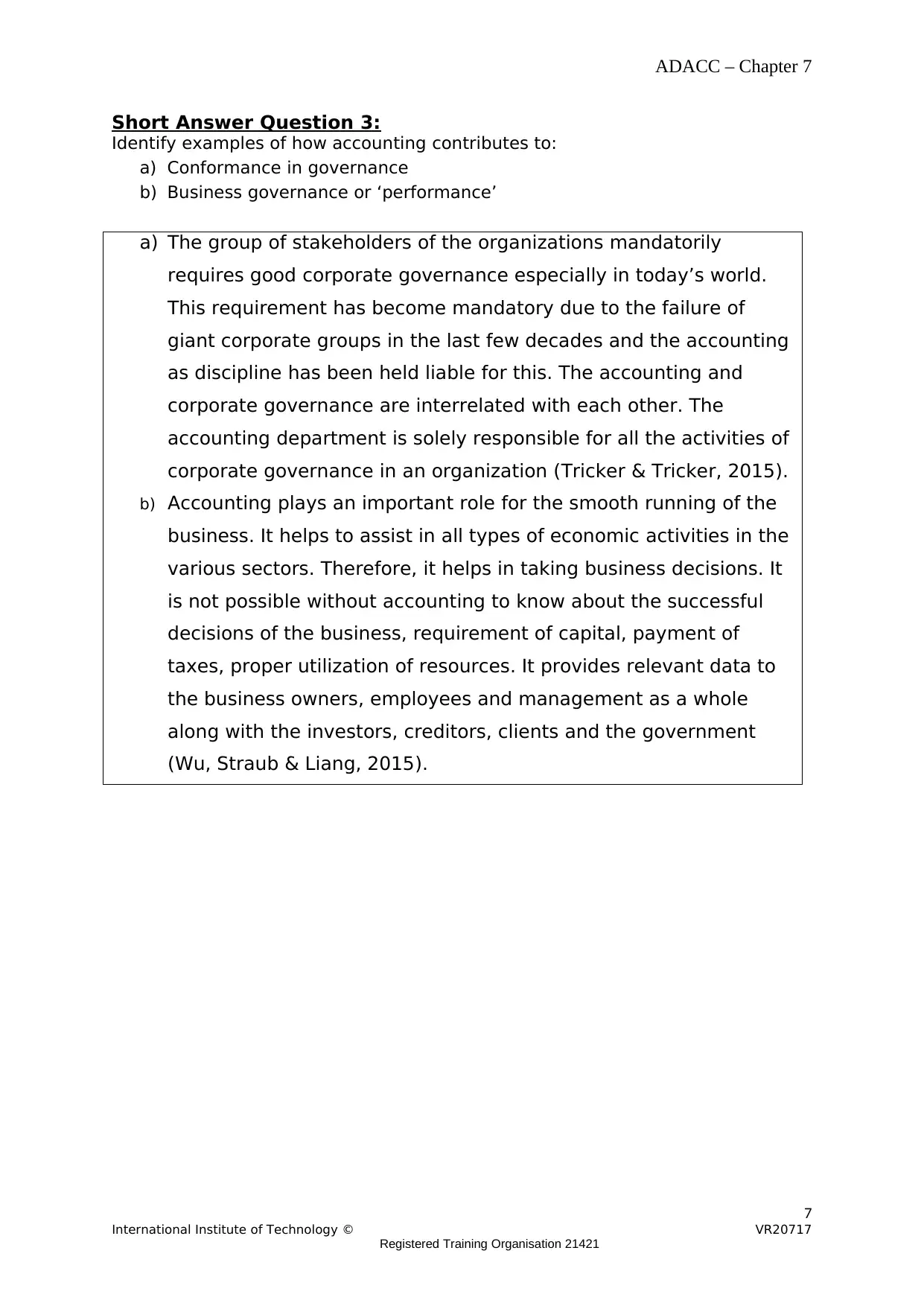
ADACC – Chapter 7
Short Answer Question 3:
Identify examples of how accounting contributes to:
a) Conformance in governance
b) Business governance or ‘performance’
a) The group of stakeholders of the organizations mandatorily
requires good corporate governance especially in today’s world.
This requirement has become mandatory due to the failure of
giant corporate groups in the last few decades and the accounting
as discipline has been held liable for this. The accounting and
corporate governance are interrelated with each other. The
accounting department is solely responsible for all the activities of
corporate governance in an organization (Tricker & Tricker, 2015).
b) Accounting plays an important role for the smooth running of the
business. It helps to assist in all types of economic activities in the
various sectors. Therefore, it helps in taking business decisions. It
is not possible without accounting to know about the successful
decisions of the business, requirement of capital, payment of
taxes, proper utilization of resources. It provides relevant data to
the business owners, employees and management as a whole
along with the investors, creditors, clients and the government
(Wu, Straub & Liang, 2015).
7
International Institute of Technology © VR20717
Registered Training Organisation 21421
Short Answer Question 3:
Identify examples of how accounting contributes to:
a) Conformance in governance
b) Business governance or ‘performance’
a) The group of stakeholders of the organizations mandatorily
requires good corporate governance especially in today’s world.
This requirement has become mandatory due to the failure of
giant corporate groups in the last few decades and the accounting
as discipline has been held liable for this. The accounting and
corporate governance are interrelated with each other. The
accounting department is solely responsible for all the activities of
corporate governance in an organization (Tricker & Tricker, 2015).
b) Accounting plays an important role for the smooth running of the
business. It helps to assist in all types of economic activities in the
various sectors. Therefore, it helps in taking business decisions. It
is not possible without accounting to know about the successful
decisions of the business, requirement of capital, payment of
taxes, proper utilization of resources. It provides relevant data to
the business owners, employees and management as a whole
along with the investors, creditors, clients and the government
(Wu, Straub & Liang, 2015).
7
International Institute of Technology © VR20717
Registered Training Organisation 21421
Paraphrase This Document
Need a fresh take? Get an instant paraphrase of this document with our AI Paraphraser
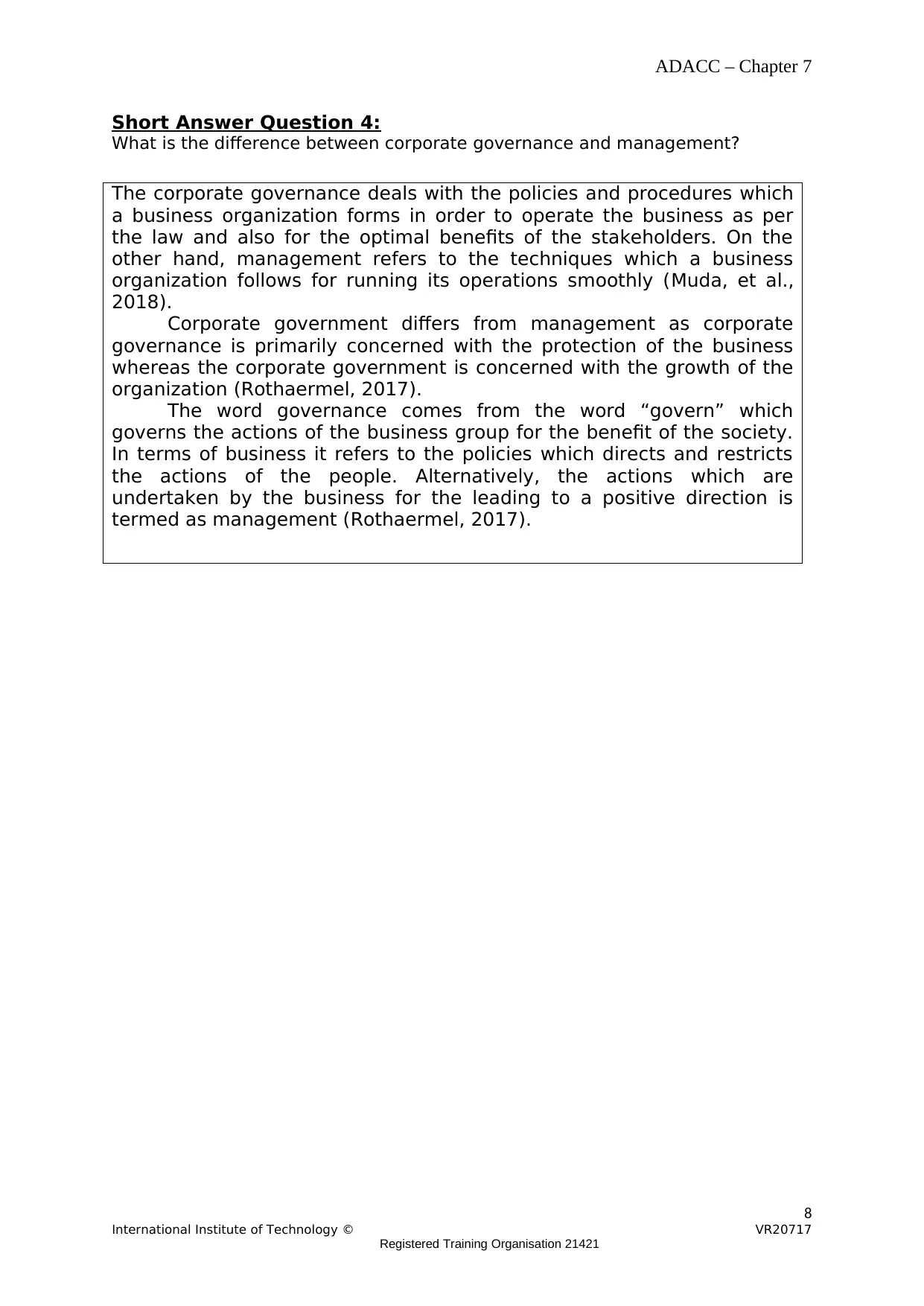
ADACC – Chapter 7
Short Answer Question 4:
What is the difference between corporate governance and management?
The corporate governance deals with the policies and procedures which
a business organization forms in order to operate the business as per
the law and also for the optimal benefits of the stakeholders. On the
other hand, management refers to the techniques which a business
organization follows for running its operations smoothly (Muda, et al.,
2018).
Corporate government differs from management as corporate
governance is primarily concerned with the protection of the business
whereas the corporate government is concerned with the growth of the
organization (Rothaermel, 2017).
The word governance comes from the word “govern” which
governs the actions of the business group for the benefit of the society.
In terms of business it refers to the policies which directs and restricts
the actions of the people. Alternatively, the actions which are
undertaken by the business for the leading to a positive direction is
termed as management (Rothaermel, 2017).
8
International Institute of Technology © VR20717
Registered Training Organisation 21421
Short Answer Question 4:
What is the difference between corporate governance and management?
The corporate governance deals with the policies and procedures which
a business organization forms in order to operate the business as per
the law and also for the optimal benefits of the stakeholders. On the
other hand, management refers to the techniques which a business
organization follows for running its operations smoothly (Muda, et al.,
2018).
Corporate government differs from management as corporate
governance is primarily concerned with the protection of the business
whereas the corporate government is concerned with the growth of the
organization (Rothaermel, 2017).
The word governance comes from the word “govern” which
governs the actions of the business group for the benefit of the society.
In terms of business it refers to the policies which directs and restricts
the actions of the people. Alternatively, the actions which are
undertaken by the business for the leading to a positive direction is
termed as management (Rothaermel, 2017).
8
International Institute of Technology © VR20717
Registered Training Organisation 21421
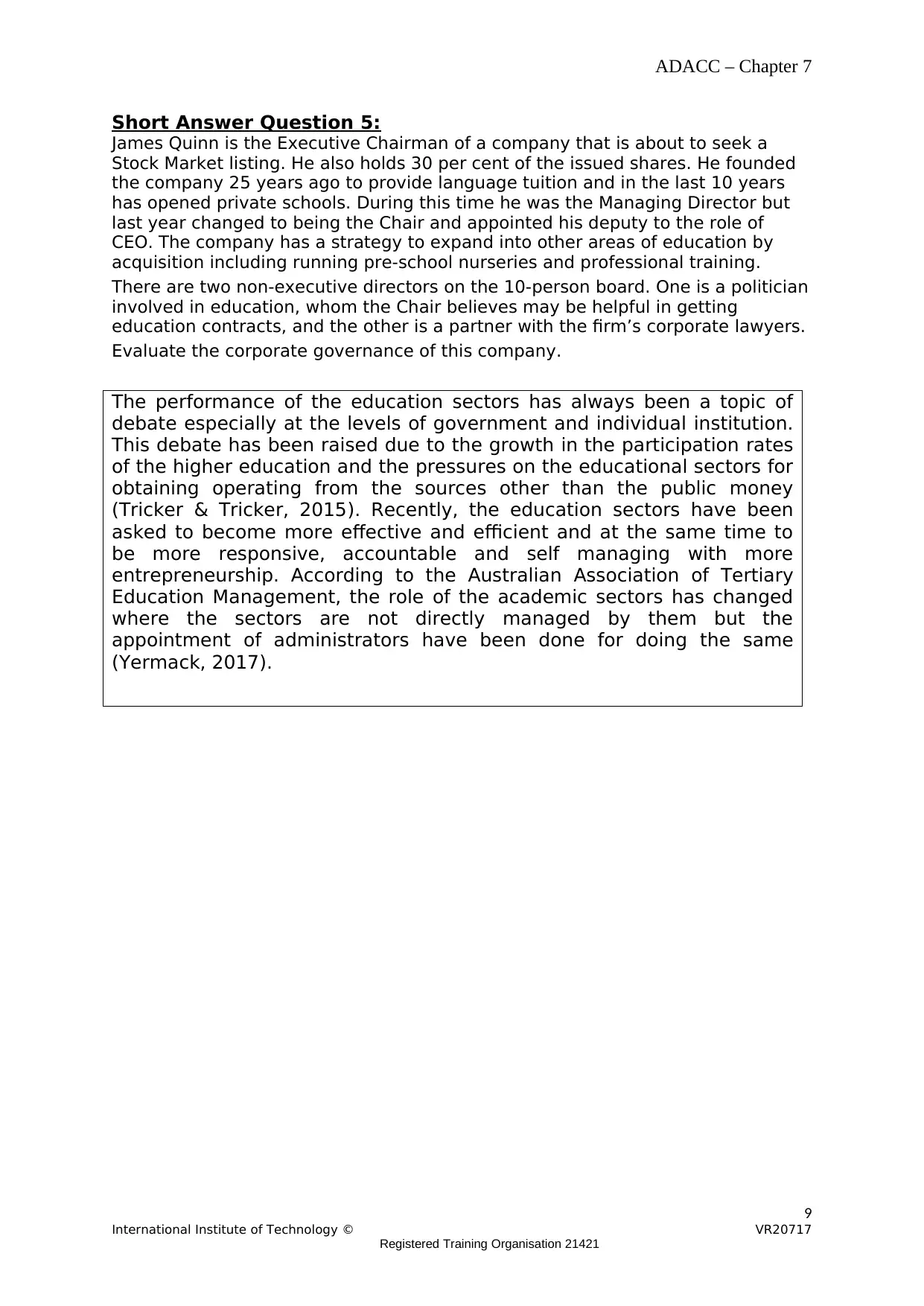
ADACC – Chapter 7
Short Answer Question 5:
James Quinn is the Executive Chairman of a company that is about to seek a
Stock Market listing. He also holds 30 per cent of the issued shares. He founded
the company 25 years ago to provide language tuition and in the last 10 years
has opened private schools. During this time he was the Managing Director but
last year changed to being the Chair and appointed his deputy to the role of
CEO. The company has a strategy to expand into other areas of education by
acquisition including running pre-school nurseries and professional training.
There are two non-executive directors on the 10-person board. One is a politician
involved in education, whom the Chair believes may be helpful in getting
education contracts, and the other is a partner with the firm’s corporate lawyers.
Evaluate the corporate governance of this company.
The performance of the education sectors has always been a topic of
debate especially at the levels of government and individual institution.
This debate has been raised due to the growth in the participation rates
of the higher education and the pressures on the educational sectors for
obtaining operating from the sources other than the public money
(Tricker & Tricker, 2015). Recently, the education sectors have been
asked to become more effective and efficient and at the same time to
be more responsive, accountable and self managing with more
entrepreneurship. According to the Australian Association of Tertiary
Education Management, the role of the academic sectors has changed
where the sectors are not directly managed by them but the
appointment of administrators have been done for doing the same
(Yermack, 2017).
9
International Institute of Technology © VR20717
Registered Training Organisation 21421
Short Answer Question 5:
James Quinn is the Executive Chairman of a company that is about to seek a
Stock Market listing. He also holds 30 per cent of the issued shares. He founded
the company 25 years ago to provide language tuition and in the last 10 years
has opened private schools. During this time he was the Managing Director but
last year changed to being the Chair and appointed his deputy to the role of
CEO. The company has a strategy to expand into other areas of education by
acquisition including running pre-school nurseries and professional training.
There are two non-executive directors on the 10-person board. One is a politician
involved in education, whom the Chair believes may be helpful in getting
education contracts, and the other is a partner with the firm’s corporate lawyers.
Evaluate the corporate governance of this company.
The performance of the education sectors has always been a topic of
debate especially at the levels of government and individual institution.
This debate has been raised due to the growth in the participation rates
of the higher education and the pressures on the educational sectors for
obtaining operating from the sources other than the public money
(Tricker & Tricker, 2015). Recently, the education sectors have been
asked to become more effective and efficient and at the same time to
be more responsive, accountable and self managing with more
entrepreneurship. According to the Australian Association of Tertiary
Education Management, the role of the academic sectors has changed
where the sectors are not directly managed by them but the
appointment of administrators have been done for doing the same
(Yermack, 2017).
9
International Institute of Technology © VR20717
Registered Training Organisation 21421
⊘ This is a preview!⊘
Do you want full access?
Subscribe today to unlock all pages.

Trusted by 1+ million students worldwide
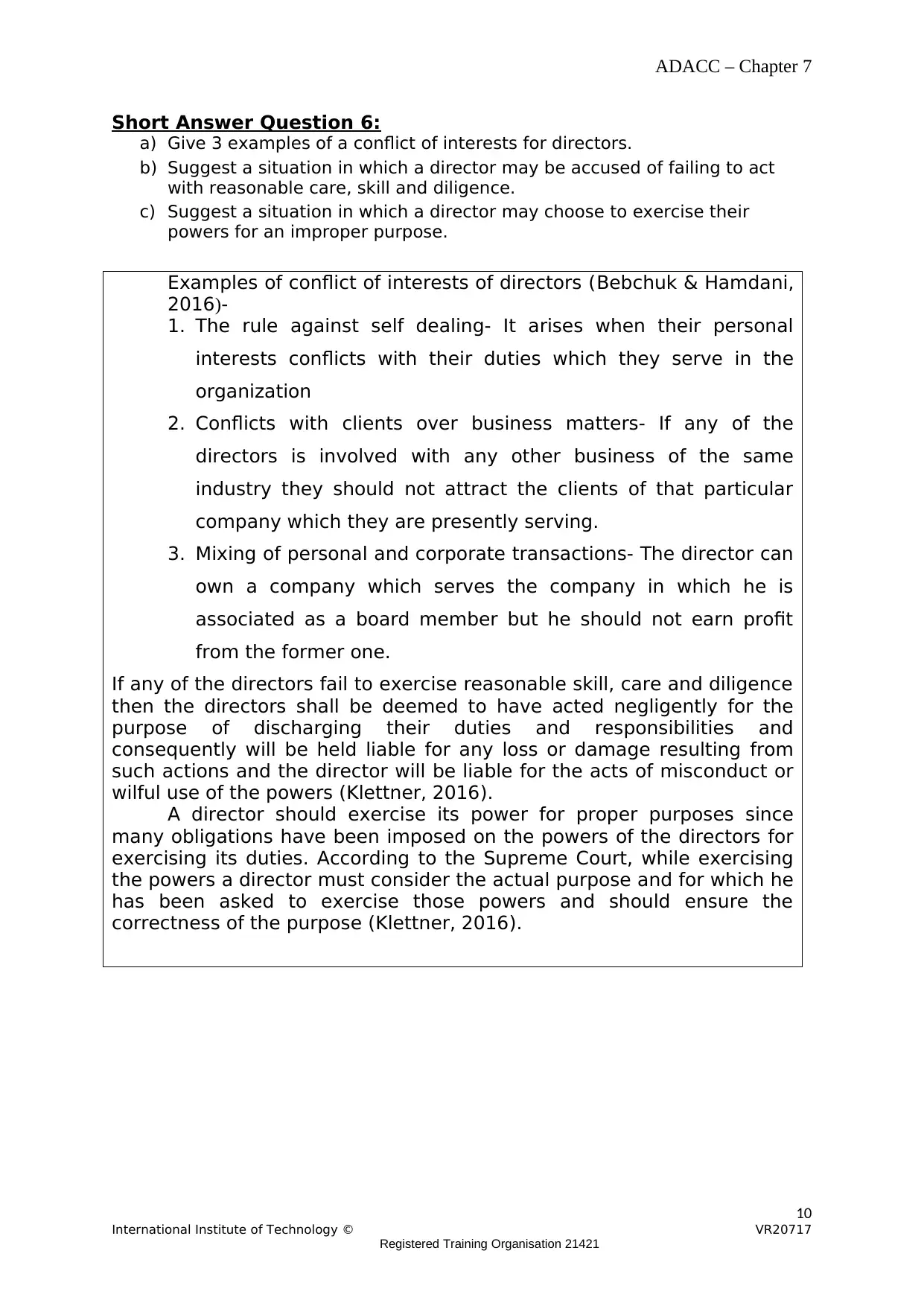
ADACC – Chapter 7
Short Answer Question 6:
a) Give 3 examples of a conflict of interests for directors.
b) Suggest a situation in which a director may be accused of failing to act
with reasonable care, skill and diligence.
c) Suggest a situation in which a director may choose to exercise their
powers for an improper purpose.
Examples of conflict of interests of directors (Bebchuk & Hamdani,
2016)-
1. The rule against self dealing- It arises when their personal
interests conflicts with their duties which they serve in the
organization
2. Conflicts with clients over business matters- If any of the
directors is involved with any other business of the same
industry they should not attract the clients of that particular
company which they are presently serving.
3. Mixing of personal and corporate transactions- The director can
own a company which serves the company in which he is
associated as a board member but he should not earn profit
from the former one.
If any of the directors fail to exercise reasonable skill, care and diligence
then the directors shall be deemed to have acted negligently for the
purpose of discharging their duties and responsibilities and
consequently will be held liable for any loss or damage resulting from
such actions and the director will be liable for the acts of misconduct or
wilful use of the powers (Klettner, 2016).
A director should exercise its power for proper purposes since
many obligations have been imposed on the powers of the directors for
exercising its duties. According to the Supreme Court, while exercising
the powers a director must consider the actual purpose and for which he
has been asked to exercise those powers and should ensure the
correctness of the purpose (Klettner, 2016).
10
International Institute of Technology © VR20717
Registered Training Organisation 21421
Short Answer Question 6:
a) Give 3 examples of a conflict of interests for directors.
b) Suggest a situation in which a director may be accused of failing to act
with reasonable care, skill and diligence.
c) Suggest a situation in which a director may choose to exercise their
powers for an improper purpose.
Examples of conflict of interests of directors (Bebchuk & Hamdani,
2016)-
1. The rule against self dealing- It arises when their personal
interests conflicts with their duties which they serve in the
organization
2. Conflicts with clients over business matters- If any of the
directors is involved with any other business of the same
industry they should not attract the clients of that particular
company which they are presently serving.
3. Mixing of personal and corporate transactions- The director can
own a company which serves the company in which he is
associated as a board member but he should not earn profit
from the former one.
If any of the directors fail to exercise reasonable skill, care and diligence
then the directors shall be deemed to have acted negligently for the
purpose of discharging their duties and responsibilities and
consequently will be held liable for any loss or damage resulting from
such actions and the director will be liable for the acts of misconduct or
wilful use of the powers (Klettner, 2016).
A director should exercise its power for proper purposes since
many obligations have been imposed on the powers of the directors for
exercising its duties. According to the Supreme Court, while exercising
the powers a director must consider the actual purpose and for which he
has been asked to exercise those powers and should ensure the
correctness of the purpose (Klettner, 2016).
10
International Institute of Technology © VR20717
Registered Training Organisation 21421
Paraphrase This Document
Need a fresh take? Get an instant paraphrase of this document with our AI Paraphraser
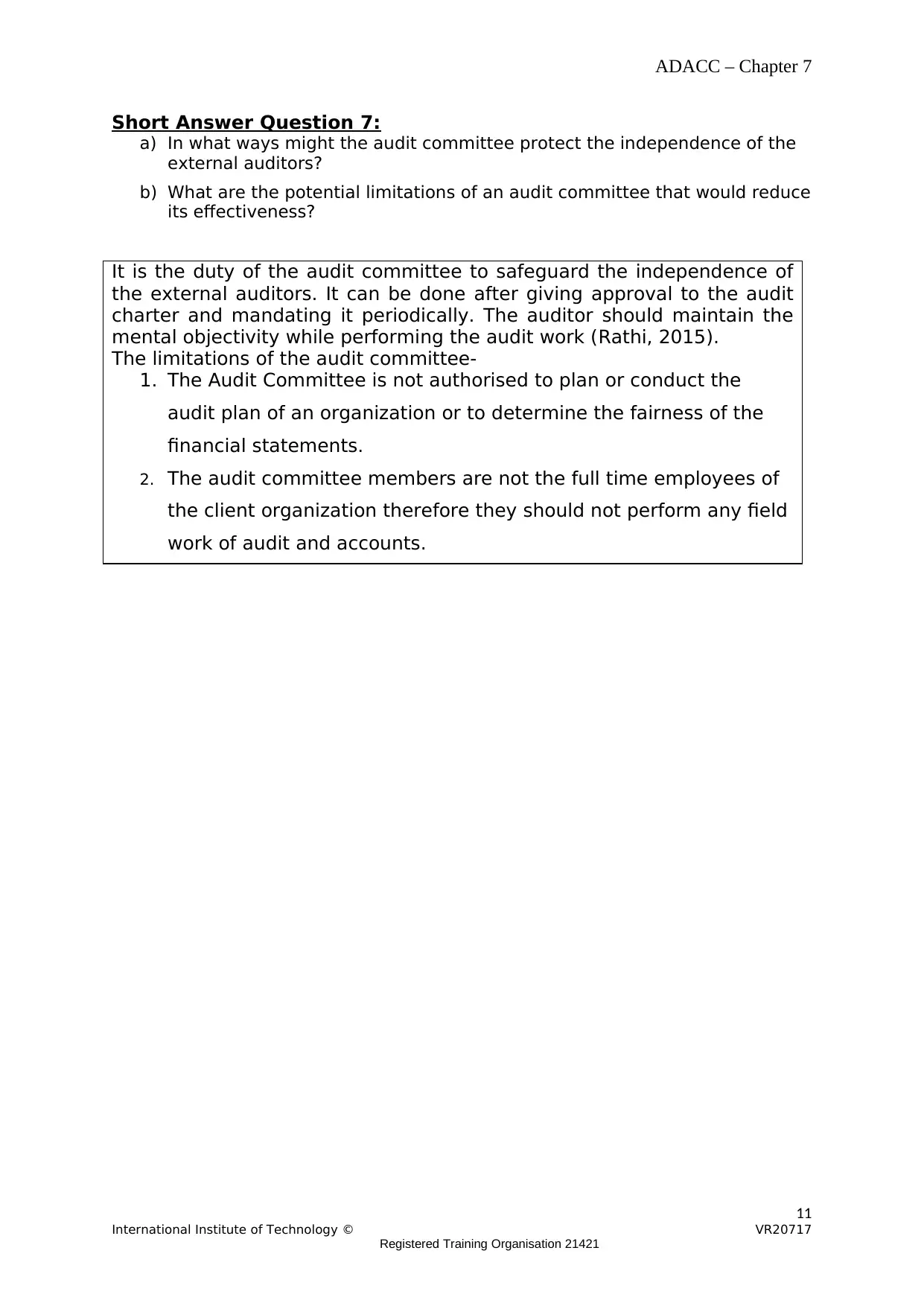
ADACC – Chapter 7
Short Answer Question 7:
a) In what ways might the audit committee protect the independence of the
external auditors?
b) What are the potential limitations of an audit committee that would reduce
its effectiveness?
It is the duty of the audit committee to safeguard the independence of
the external auditors. It can be done after giving approval to the audit
charter and mandating it periodically. The auditor should maintain the
mental objectivity while performing the audit work (Rathi, 2015).
The limitations of the audit committee-
1. The Audit Committee is not authorised to plan or conduct the
audit plan of an organization or to determine the fairness of the
financial statements.
2. The audit committee members are not the full time employees of
the client organization therefore they should not perform any field
work of audit and accounts.
11
International Institute of Technology © VR20717
Registered Training Organisation 21421
Short Answer Question 7:
a) In what ways might the audit committee protect the independence of the
external auditors?
b) What are the potential limitations of an audit committee that would reduce
its effectiveness?
It is the duty of the audit committee to safeguard the independence of
the external auditors. It can be done after giving approval to the audit
charter and mandating it periodically. The auditor should maintain the
mental objectivity while performing the audit work (Rathi, 2015).
The limitations of the audit committee-
1. The Audit Committee is not authorised to plan or conduct the
audit plan of an organization or to determine the fairness of the
financial statements.
2. The audit committee members are not the full time employees of
the client organization therefore they should not perform any field
work of audit and accounts.
11
International Institute of Technology © VR20717
Registered Training Organisation 21421
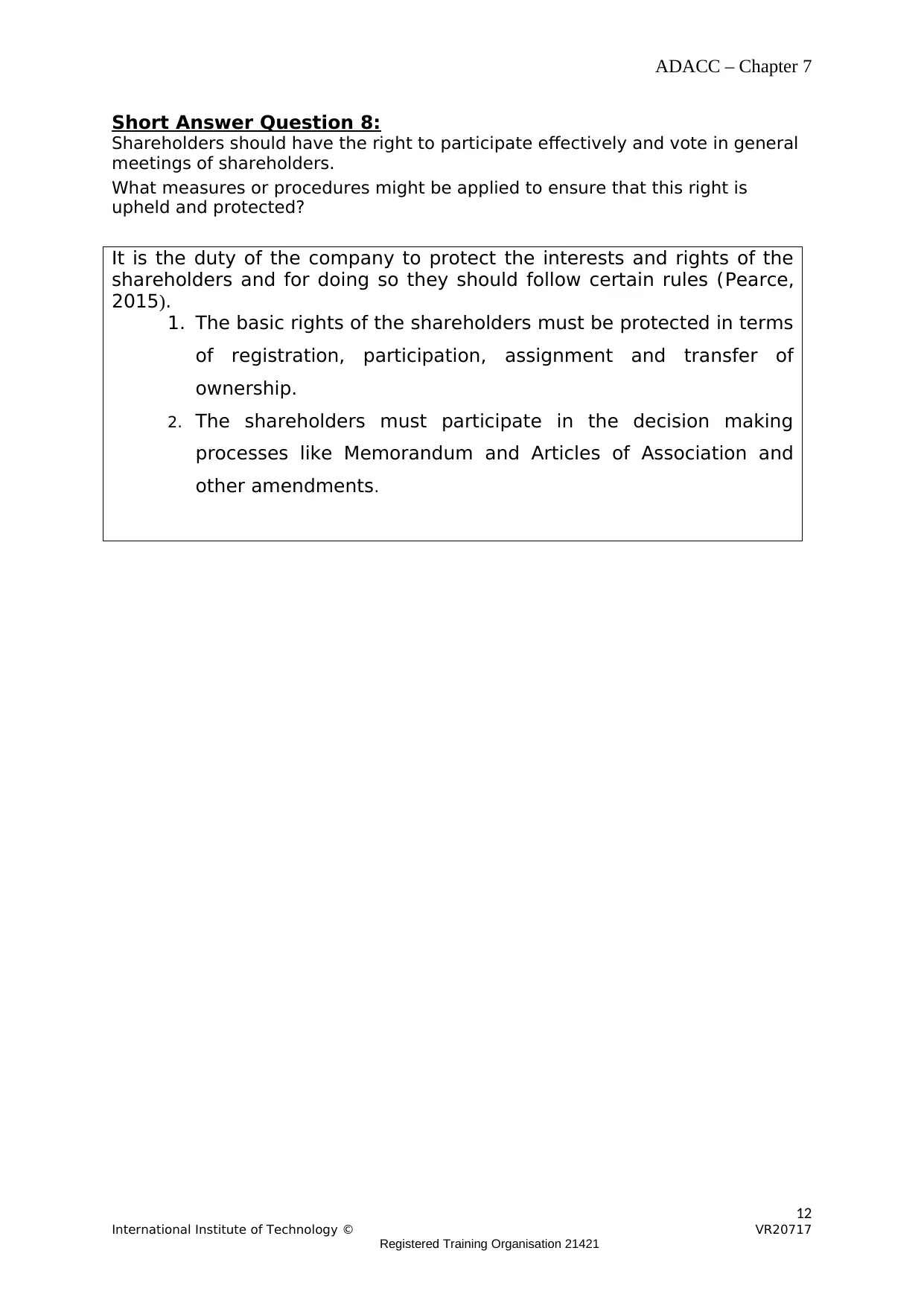
ADACC – Chapter 7
Short Answer Question 8:
Shareholders should have the right to participate effectively and vote in general
meetings of shareholders.
What measures or procedures might be applied to ensure that this right is
upheld and protected?
It is the duty of the company to protect the interests and rights of the
shareholders and for doing so they should follow certain rules (Pearce,
2015).
1. The basic rights of the shareholders must be protected in terms
of registration, participation, assignment and transfer of
ownership.
2. The shareholders must participate in the decision making
processes like Memorandum and Articles of Association and
other amendments.
12
International Institute of Technology © VR20717
Registered Training Organisation 21421
Short Answer Question 8:
Shareholders should have the right to participate effectively and vote in general
meetings of shareholders.
What measures or procedures might be applied to ensure that this right is
upheld and protected?
It is the duty of the company to protect the interests and rights of the
shareholders and for doing so they should follow certain rules (Pearce,
2015).
1. The basic rights of the shareholders must be protected in terms
of registration, participation, assignment and transfer of
ownership.
2. The shareholders must participate in the decision making
processes like Memorandum and Articles of Association and
other amendments.
12
International Institute of Technology © VR20717
Registered Training Organisation 21421
⊘ This is a preview!⊘
Do you want full access?
Subscribe today to unlock all pages.

Trusted by 1+ million students worldwide
1 out of 17
Related Documents
Your All-in-One AI-Powered Toolkit for Academic Success.
+13062052269
info@desklib.com
Available 24*7 on WhatsApp / Email
![[object Object]](/_next/static/media/star-bottom.7253800d.svg)
Unlock your academic potential
Copyright © 2020–2025 A2Z Services. All Rights Reserved. Developed and managed by ZUCOL.





